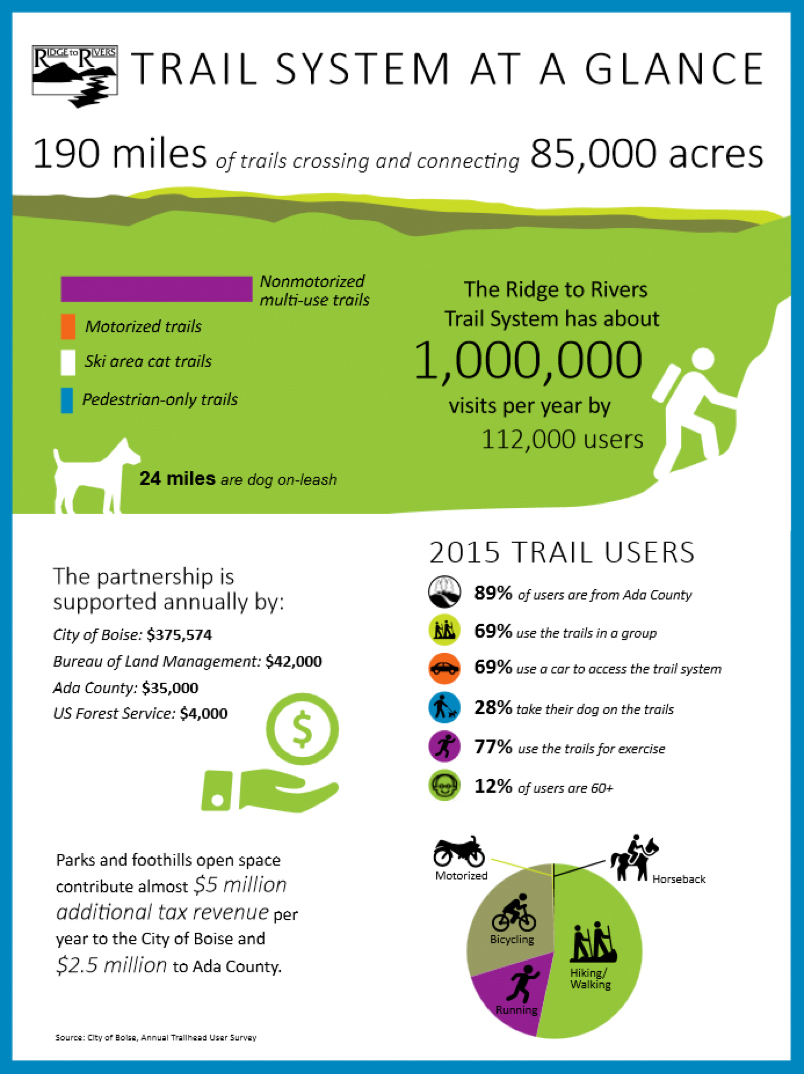Economic Development
Trails mean business! Outdoor recreation opportunities can be a major source of revenue and economic development for communities. Trails attract people to visit, move to, stay in and ultimately spend money in communities.
Almost half of Americans participated in outdoor recreation activities in 2018. Trail sports (running, biking, and hiking) are three of the five most popular outdoor activities for youth and adults in the United States. Trail opportunities influence where Americans choose to visit and live:
- In Whitefish, Montana, outdoor recreation was the number one reason why visitors come to Whitefish and why locals stay in the community (Headwaters Economics).
- A study by the National Association of Realtors and Homebuilders found that proximity to walking/jogging/biking trails was the second most important community amenity to prospective home buyers.
- Mountain bikers frequently travel to ride, with the average rider taking two mountain bike trips a year and bringing their bike along on other trips as well. The average survey respondent will travel 566 miles per trip (Singletracks).
Trail users, both locals and visitors, support the local economy through significant spending at restaurants, lodging, gas stations, outdoor gear stores, and other businesses.
- In Whitefish, overnight outdoor recreation visitors typically spend $278 per day. Residents who use the local trail system typically spend about $1,400 per year on outdoor gear at local stores, compared to $600 for non-trail users.
- A Vermont study of trail user spending found that local day users (i.e., Laramie residents) spend $11 per day in a community on average, non-local day users (i.e., Cheyenne residents) spend $70 per day, and overnight visitors spend $176 per day (SE Group)
- In Fruita, Colorado, consumer spending overall is 25% higher in the spring and fall, peak riding season.
Trail-related spending, by both visitors and locals, can generate significant revenue and create jobs in the local economy.
- The Whitefish Trail network, a 44-mile trail system used primarily by locals, generates an estimated $6.4 million in consumer spending annually. $3.6 million of that spending is from local trail users.
- In the Mad River Valley of Vermont, an 8-mile trail network sees almost 40,000 annual visits, generating $1 million in consumer spending, $182,000 in federal, state, and local taxes, and 13 jobs.
- In Crosby, Minnesota, a new 25-mile trail network attracts 20,000 visitors annually who generate an estimated $2 million for the local economy. The new trail system has also spurred 15 new businesses in town, many of which were started by young people who have chosen to live and work in the area due to the trail system (International Mountain Bike Association)
- The 190-mile trail system surrounding Boise, Idaho sees about 1 million annual visits per year, generating $5 million for the local economy. Of those visits, 89% are by residents of the surrounding county and 54% are hikers/walkers, 27% are bikers, and 17% are runners (Ridges and Rivers).
Pilot Hill Economic Potential:
The Laramie Mountain Bike Series averages 200 riders/each Tuesday night race. Racers range in age from 2-70+ years old. In 2017, 40% of racers were from Laramie, another 40% traveled at least 60 miles from somewhere in Colorado, and 14.5% were from Cheyenne (40 miles away).
From-town events on the Pilot Hill property represent enormous economic potential for our community.
Host towns of National Interscholastic Cycling Association High School races see an average economic benefit of $200,000/race. Laramie could potentially host a race as early as 2020.
Governor Mead's Outdoor Recreation Task Force (ORTF) members agreed Outdoor Recreation (OR) can:
- attract and retain skilled workers and the businesses that employ them
- create a diverse economic engine to help stabilize and enhance WY and its communities
- mitigate cyclical nature of boom and bust dynamics
- provide mental, spiritual, and physical health and quality time for families and individuals
- create livable communities and enhance social capacity by connecting residents to the outdoors
- engage people in conserving natural landscapes and resources
ORTF felt WY recreationists, businesses, communities, and governments at all levels should:
- support OR access and opportunities close to local communities
- recognize the state's scenic, wildlife, and rec resources as irreplaceable national treasures
- reach out to outdoor associations and trade groups and include them in decision-making processes
- recognize the link between OR and public health
There were 11 recommendations from the ORTF, but at the root of each recommendation is the need for each community to capitalize on their unique OR amenities.
Local example where the unique OR amenity is the trail system:
Curt Gowdy State Park
- 2005: $100,000 in revenue with no trail system
- 2011: almost $250,000 in revenue with trail system
- 2008: park visitation doubled while it dropped in all other WY state parks

